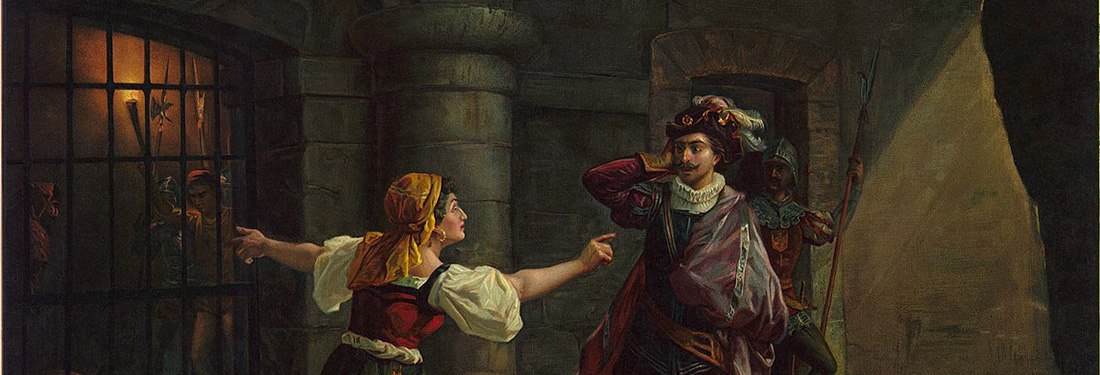
Every article, every review, every scholarly piece of writing I’ve read starts with the idea that above all else, Trovatore is known for its absurdity of plot. Parodies began appearing in Italy and abroad within months of the opera’s premiere. It’s an opera ridiculed by Gilbert & Sullivan with mixed up babies in Pirates of Penzance. What the Marx Brothers do to Il trovatore should have been done to opera a long time ago – in 1935, Groucho, Harpo, and Zeppo skewered the opera in the movie A Night at the Opera’s finale and made famous what became known as The Kitty Carlisle High Cs (more on that later). And then there’s Mad Magazine; back in 1967 the Opera News cover story featured three full pages of how Mad Magazine might explain what went on between the scenes of the opera (again, later). Not to be outdone, Placido Domingo and Luciano Pavarotti in their joint Opening Night Gala of the 1993 Season performed Act III of Trovatore TOGETHER! You can have a bit of the “Di quella pira” here:
Il trovatore, depending on how you count, was Verdi’s 16th or 18th opera. That’s a bit past the mid-point as Verdi wrote 26 or 28 operas. I include Jerusalem and Aroldo as separate operas as they differ so greatly from their predecessors, I Lombardi and Stiffelio, respectively, so that makes 28. More relevantly, Trovatore is the centerpiece of Verdi’s romantic trilogy that falls right between Rigoletto and La Traviata and the three make up the great triptych that separates Verdi’s early operas from his later, mature ones. And those three, plus Aïda, are the favorite and most frequently produced operas of Verdi. The threesome is unarguably his most melodic … well, maybe Ernani can be included. Il trovatore also falls into another group: Verdi’s four “Spanish” operas, i.e., those that more-or-less take place in Spain and coincidentally my four favorite Verdi operas: Ernani, Il trovatore, La forza del destino, and Don Carlo(s).
There’s little point in discussing that preposterous plot or its history – one can easily Google it – other than to say that the opera was based on a popular, sprawling 1836 Spanish melodrama El trovador by Antonio Garcia Gutierrez originally written about a mid-15th Century civil war which took place in Biscay and Aragon. There was an actual Count di Luna, but actual history stops there. The opera was first performed at the Teatro Apollo, Rome, January 19, 1853. Its immense popularity – albeit a popular success rather than a critical one – came from some 229 productions worldwide in the three years following its premiere; of all his works, Il trovatore was Verdi’s most loved during his lifetime. The opera had its American premiere in 1855 at the Gilded Age’s New York Academy of Music. Its librettist was Salvatore Cammarano who had written several libretti for Donizetti, in particular Lucia di Lammermoor, Roberto Devereux, and Poliuto; for Mercadante, Orazi e Curiazi and Virginia; and for Verdi Alzira, Battaglia, Luisa Miller, and Stiffelio. Cammarano died before completely completing Trovatore.
Another bit of irrelevant history is that Il trovatore was the first opera that I ever stood for, on the side of the Family Circle in the old Met which, as I recall it now, was like being in a dog’s x-pen. The cast was Leontyne Price, Irene Dalis, Richard Tucker, and Robert Merrill. It was a Saturday matinée, January 18, 1964, and I would have been a senior in high school. The cost was $2. I don’t remember the production but it very likely could have been set “properly” in the 15th Century. Checking in the currently deplorable Met archives, it was a new Motley (in more ways than one) production from the opening night of 1959 with Antonietta Stella, Giulietta Simionato (in her debut), Carlo Bergonzi, and Leonard Warren – aargh … one groans in ecstasy at that cast.
The broadcast a few months later substituted Ettore Bastianini for Warren and there are moments that can only be classified as sublime! If nothing else, it is authentically Italian. Since then, the Met has not had a good history with their Trovatore productions. The next one (1969 Merrill/Colonello with another dream cast of Price, Grace Bumbry, Placido Domingo, Sherill Milnes) I recall hearing that even Leontyne hated. I can’t remember the following, but one in 2000 was set during the American Civil War and was so bad it was literally laughed at and booed. The present Met production by the ubiquitous David McVicar has worked well. Set during the Spanish War of Independence of the 1810s, it is very Goya-esque. Around the same time period, the Italian Risorgimento also works well and it is the period during which Verdi was writing the opera. I can’t imagine (and don’t want to) a modern dress production, but there’s one coming up in Houston this month (see the story in this month’s Opera magazine).
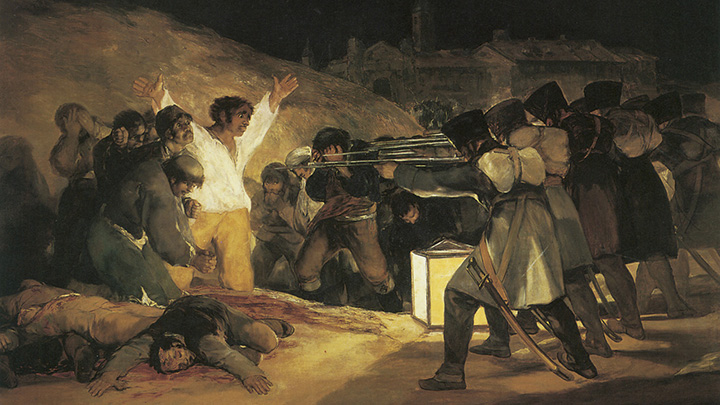
The 3rd of May 1808, painted 1814 by Francisco Goya
We can laugh at the dramatic absurdities of Il trovatore and it is perfectly true that, with the possible exception of Azucena, who clearly suffers from PTSD, its characters never really come to life as those in Rigoletto and Traviata most certainly do … an evil hunchback and a sympathetic demimondaine are interesting in their complexities and their developments as human characters. But Trovatore’s characters? Not so much. Of the three masterpieces, Trovatore is undoubtedly the weakest in terms of dramatic continuity and characterization, yet such is the sheer intensity of Verdi’s musical invention and the opportunities for great singing that we still long to encounter the work in the theatre.
Packed with all manner of implausible coincidences, it is a love story and a drama of vengeance with the underlying irony of two rivals in love with the same woman who are also enemies in a civil war (and brothers without knowing it). It is totally devoid of intellect; the appeal is to the senses. Perhaps it is not the composer’s supreme masterpiece, it is nevertheless a late flowering of the Italian bel canto romantic tradition. It is a valuable reminder that the laws of musical theatre do not have to conform to those of literary ‘drama,’ that is, devoid of Aristotelian unities in order to present a coherent masterpiece. Verdi’s Trovatore is a work entirely in keeping with the aesthetics of the time of its creation. Garcia Gutierrez’s play El Trovador is a perfect example of Romantic theatre, where any hint of rationalism should be avoided and an exaggerated state of emotionalism should be reached in order to enlighten the audiences exclusively through the heart, not the mind.
A mistake is to get bogged down in ‘interpretation.’ Romantic characters tend to seem like cardboard when given psychological analysis. Yes, there is racial hatred in the work… torture, kidnapping, and so on. Azucena’s mother is accused of bewitching a child and immediately burned at the stake, no questions asked, no legal protection. She is lynched because she was Roma. Racial hatred blazes from the men in the first scene of both the first and third acts. Above all however, Il trovatore is about vengeance – “vendetta,” “vendica,” “vendicata” – words that seems to show up in just about every Verdi opera. Most obviously, it is the obsessive desire of Azucena to avenge her mother.
When we first meet her, she is already obsessing over “mi vendica!” But she is not the only one who’s out for vengeance. So is the obligatory evil baritone, Count di Luna. We first learn of it in the opening moments as Ferrando relates how the Count is charged to avenge the death of his supposed brother at Azucena’s doing. In the next act, we hear Azucena’s version of it. Both are horror stories but from different perspectives. Di Luna is equally out to seek revenge on Manrico for winning Leonora whom he also loves. But the ultimate revenge is that Manrico is put to death by his own brother, the Count. The last words of the opera are Azucena’s: “Sei vendicata, o madre!” – “Mother, you are avenged!”
In Verdi’s eyes, Azucena is the main character of the opera. Indeed, Verdi was going to name the opera Azucena or La Zingara (“The Gypsy”) – but that was already taken by Donizetti for a very different kind of opera. Some 20 years before the opera begins, Azucena has undergone a serious shock on witnessing her mother’s dying at the stake and is forced to commit to revenge. But instead of killing her mother’s enemy’s son, she accidentally kills her own baby by the same element which killed her mother: fire. Azucena is torn between her conscience and her heart, the most extreme of situations. Throughout the whole opera, the schizophrenic Azucena is alternatively saving Manrico and leading him to death.
Azucena’s music is no longer the usual cavatina and cabaletta; she “speaks” authentic Musikdrama language. We hear her first singing a conventional canzone, “Stride la vampa” only to hear her deconstruct it a few moments later in “Condotta ell’era in cepi” – where the trills are left aside so that the orchestra and hair raising declamation tell the true story behind the song. One could almost pinpoint this spot as Verdi’s transition from his youthful bel canto style operas to his more mature masterpieces of Music Drama. Verdi also here discovered the potentialities of the mezzo-soprano voice. In Trovatore the mezzo-soprano first appears as the female equivalent of the baritone standing in the same relation to the full soprano as the baritone to the tenor. In this he was inspired by the role of Fidès in Meyerbeer’s 1849 Le Prophète. Before, mezzo roles in Verdi’s operas were considered supportive; Azucena led to Eboli and Amneris.
All that said, one does not go to Il trovatore for the story. Enrico Caruso’s famous dictum was, “all you need for Il trovatore are the four greatest singers in the world.” As it turns out, maybe Caruso should have included the conductor? With or without, the opera is an abundance of great melodies. The music is irresistible, melodically intoxicating. Even when the accompaniment is a bel canto oom-pah-pah, inspiration is made up for with the rhythmic propulsion and the instrumental palette. It is swift in action and perfectly uniform in atmosphere and feeling. One is swept away by the vitality and sheer intensity of Verdi’s musical invention. Every Verdi opera has qualities that are part of his individuality as a composer and singular bits of melody, rhythm, and orchestration that create the particular opera’s unique world of sound – it’s tinta. Trovatore and Traviata are unmistakably by the same composer, but the difference in their musical worlds are far apart. In Trovatore, the tinta is extroverted and sometimes even harsh and violent. The rhythmic style that Verdi gives to Azucena’s camp are part of the tinta of Trovatore and peculiar to it.
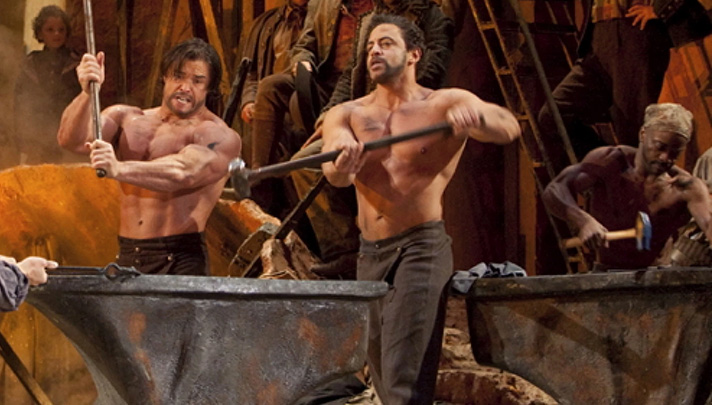
Sometimes the Anvil Chorus is better seen than heard. (Ken Howard/Metropolitan Opera)
Above all else, opportunities for great singing abound. Perhaps not a lot can be said about the characters, but Verdi supplied them with plenty to sing about. I always feel that Il trovatore’s leading role is Leonora even though the title character is the tenor and the protagonist is the mezzo. Leonora has two great solo scenes. She goes from a lyric in her first aria to dramatic by the last act and that marks the change of Verdi’s style. She opens in the second scene with “Tacea la notte placida” and its cabaletta “Di tale amor.” But it’s her fourth act scena that transforms the role into a great one.
As Verdi wrote Trovatore and Traviata almost at the same time, the role of Leonora undergoes a kind of development similar to the one experienced by Violetta. The tessitura gets lower and the lyric writing develops to a more dramatic vocalization. I would venture to say that Verdi ended his “early” i.e., bel canto period with Violetta’s great double aria, “Ah, fors’è lui … Sempre libera,” even though there were still remnants of the recitative-cavatina-recitative-cabaletta format as late as Forza and Aïda.
However, arguments can be made for Leonora’s 18-minute traversal of that territory, “Siam giunti … D’amor sull’ali rosee … Miserere … Tu vedrai,” as being the culmination of the structure. Of course, one has to think of the “Miserere” as the intervening recitative, considerably extended; and the cabaletta is usually cut or we’re lucky to get at least one verse of it. But in its entirety, it is a phenomenal moment not only in the opera but in the entire œuvre. Offstage, a choir of monks sings a funeral chant imploring mercy; Leonora, beneath the tower that imprisons Manrico, sings of terror and her love, while Manrico also longs offstage for his death and for Leonora not to forget him. All this to three very distinct, different melodies. There is a classic, and justifiably so, recording from 1910 sung by Frances Alda with Enrico Caruso’s seemingly endless legato in the tenor melody:
Now we can hear the famous “Kitty Carlisle high Cs” – Alda interpolates them for the As in one of the repetitions of “di te, di te scordormi?” For his part, Caruso interpolates a B-flat on the “or” of Leonora when he sings it for the final time. I thought I had never heard anyone else do that – and I don’t know why not, it’s wonderful – but Francesco Casanova did it at the “Bel Canto Il trovatore” at Caramoor –again, more on that later.
I know you’re dying to hear it, so for the record, here’s the original KC-hi-C:
I’m pretty sure that the only time the entire scene, i.e., with both verses of “Tu vedrai,” has been done at the Met was by Anna Netrebko in 2015. Likewise, I’m pretty sure Monserrat Caballé was the first to sing that cabaletta, but with only one verse; at least a big deal was made of it. It was spectacular and is my favorite performance of the complete scene. At the performance following the broadcast, she even included the high Cs. It is a totally demented performance, as is the entire performance and if ever an opera was demented, it’s Il trovatore. (Read your Ethan Mordden.) It used to be online but not is not anymore; this is from different performances and sort of lacks the “dementia” of the Met performance, but still….
According to one account, the first imported high C in “Di quella pira,” was introduced by the original tenor Carlo Baucardé in Florence in 1853. But a verbal tradition handed down amongst tenors related at a public lecture by Giovanni Martinelli, traces it to the tenor Enrico Tamberlick who wished to astonish Rossini with his high C-sharp ‘de poitrine’ (from the chest) and was told politely to hang it up in the hall and retrieve it on his way out. Tamberlick was the creator of Alvaro in Forza. Verdi was more compliant. Before asking his permission to include the note in question, Tamberlick had already experimented with it in various provincial theaters where, he told the composer, it was in great demand with the public. “Far be it from me to deny the public what it wants,” Verdi had answered drily, “just so long as it’s a good top C….”
Second verses are not necessarily pure gain. (I’ll argue why they belong later.) Much of the impact of “Di quella pira” is due to its brevity; to repeat it is to dilute it. We can ignore the fact that the lines written in for Leonora as a bridge between the two verses are simply terrible. In any case, such repeats are better dropped unless the performer is not only an exciting one, but one who offers some variants the second time around and modern singers and conductors seem to regard this as profanation. The music is no longer important, the composer is ignored, the important thing is the staging… Oops. Sorry, I got distracted. I don’t much care whether both verses are sung or not. I don’t even much care if the tenor lowers the C. My pet peeve is that when sung live, almost every tenor cuts the interjections (I don’t know what else to call them, but they start with “Madre infelice” and so on) until we get to the “All’armi.” Obviously, they are saving their breath for the biggie. I don’t particularly have a favorite “Pira,” but this (featuring a B) will do:
The baritone role is more conventional. In the back of our minds, we should not forget that it is not he who performs the misdeed that starts the plot and, accordingly, it is hard to tell in the end if he is not also victim of it. On the other hand, most of his music doesn’t really tell us that. Contradictorily, Di Luna’s “Il balen del suo sorriso” may be one of the most beautiful declarations of love that Verdi ever wrote for baritone; despite that, surely only a psychopath would fail to see that the object of his desire would rather kill herself than succumb to his advances.
My favorite performance of “Il balen” is sung by Dmitri Hvorostovsky at the 1995 Richard Tucker Gala. Di Luna was the last role Hvorostovsky performed at the Met and it was telecast on October 3, 2015. Everyone knew that he was dying of a brain tumor and during his curtain call, each member of the orchestra threw a flower on to the stage.
As long as we’re doing “Great Performances” here, this is also a fun watch – you’ll probably want to watch the entire concert. A 1981 Live From Lincoln Center presentation: Joan Sutherland, Marilyn Horne, and Luciano Pavarotti. (It’s hardly necessary to say who the conductor is.) This was sort of the culmination of two prior telecasts of evenings with Sutherland and Horne, and then Sutherland with Pavarotti. The trio concert ends with the final scene of Trovatore. They’re not much better here than they are on the Decca recording, but it’s still fun to see them do it live. Regardless, there is a lot of great singing here. The real highlight is the intermission feature with the three stars discussing bel canto.
Great singers have tackled its four great roles throughout its history, especially at the Met. Il trovatore premiered at the Metropolitan Opera House on October 26, 1883 five days after the House opened. It’s cast included Alwina Valleria, Zelia Trebelli, Roberto Stagno, and Achille Augier. Perhaps those names are not familiar now to us, but since then casts have included such legendary names as:
- Emmy Destinn-Giovanni Martinelli-Pasquale Amato conducted by Toscanini
- Emma Eames-Louise Homer-Enrico Caruso-Riccardo Stracciari
- Rosa Ponselle-Homer-Giacomo Lauri-Volpi–Ezio Pinza,
- Ponselle-Marion Telva–Giovanni Martinelli with Tullio Serafin conducting
- Zinka Milanov-Bruna Castagna-Jussi Björling,
- And Milanov and Leonard Warren
In addition to the already mentioned Price-Dalis-Tucker-Merrill and Stella-Simionato-Bergonzi-Bastianini, in more recent years:
- Leontyne Price-Grace Bumbry-Placido Domingo-Sherrill Milnes
- Joan Sutherland-Shirley Verrett-Luciano Pavarotti
- And Montserrat Caballé-Fiorenza Cossotto-Placido Domingo-Robert Merrill
It has to be mentioned that Price and Franco Corelli made their debuts together on January 27, 1961. Lest I be accused of forgetting Beniamino Gigli, among others, I didn’t … it’s just that out of the 510 performances he sang at the Met, none of them included Il trovatore. In all, Trovatore has been performed 655 times at the Met and is its 11th most performed opera. The performance that opens next Saturday will be its 656thperformance.
Next week, we’ll look at some choice recordings of the opera!


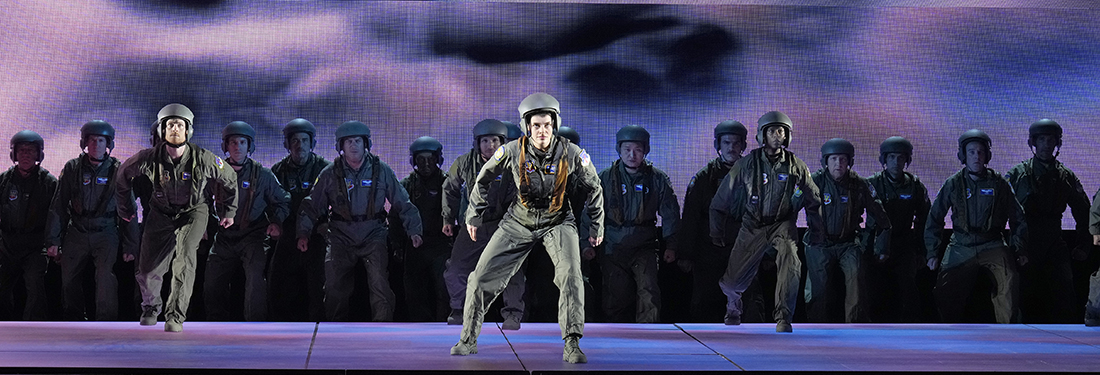



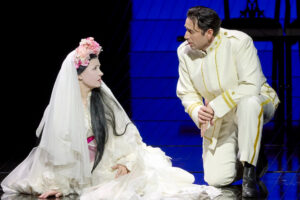
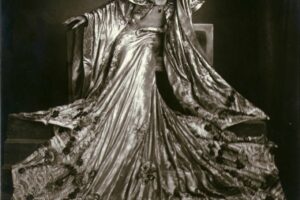





Comments